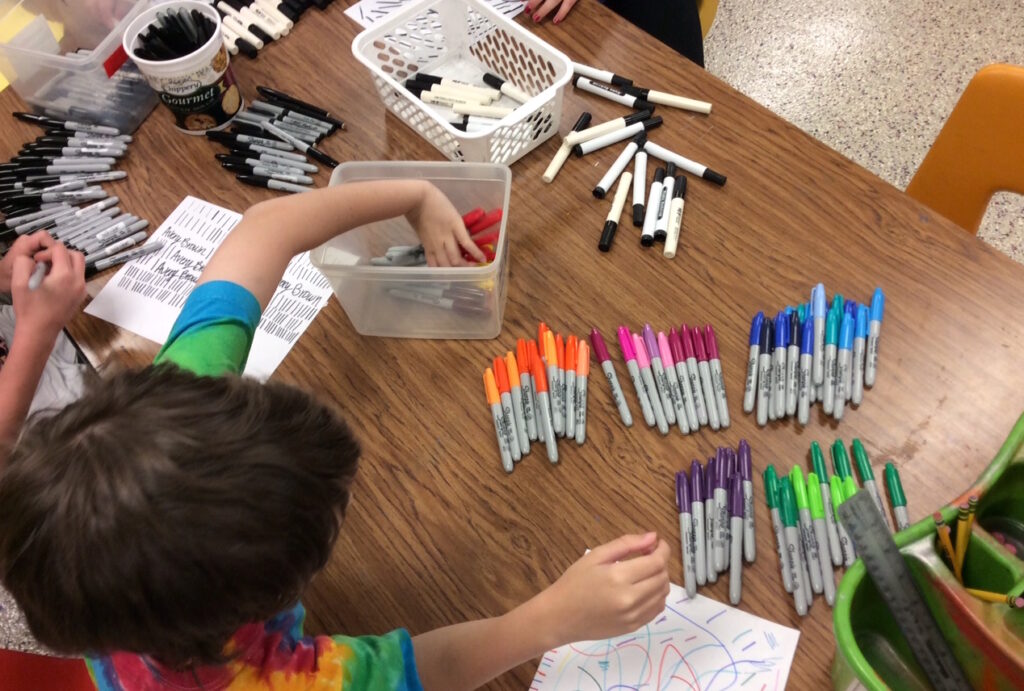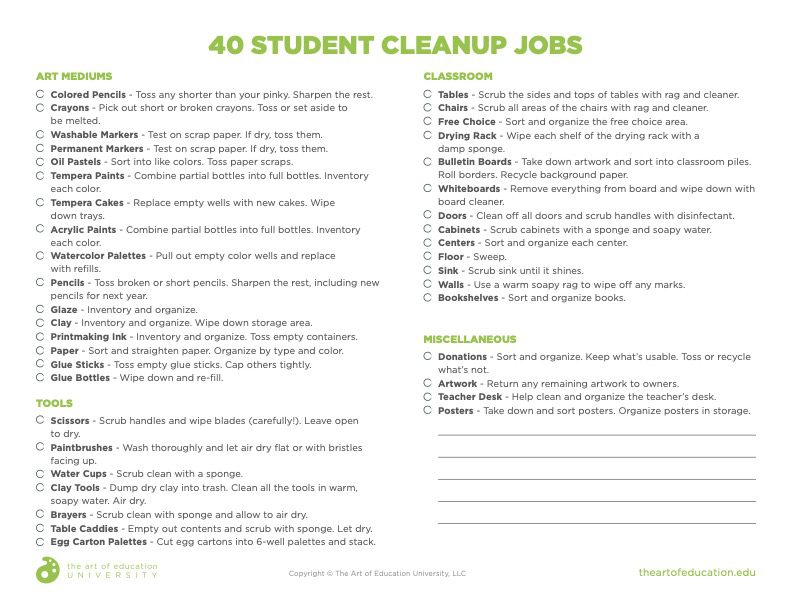Near the end of every school year, I have my oldest students in the school help me shut down the art room for summer. These students help me complete a long list of chores that will get the art room ready to go for the following school year. In order to help you get some things knocked off your to-do list, I wanted to share with you the chores my students help me complete during those last few days of school. Be sure to download the entire list at the end of this article!
40 Student Cleanup Jobs

Art Mediums
- Colored Pencils – Toss any shorter than your pinky. Sharpen the rest.
- Crayons – Pick out short or broken crayons. Toss or set aside to be melted.
- Washable Markers – Test on scrap paper. If dry, toss them.
- Permanent Markers – Test on scrap paper. If dry, toss them.
- Oil Pastels – Sort into like colors. Toss paper scraps.
- Tempera Paints – Combine partial bottles into full bottles. Inventory each color.
- Tempera Cakes – Replace empty wells with new cakes. Wipe down trays.
- Acrylic Paints – Combine partial bottles into full bottles. Inventory each color.
- Watercolor Palettes – Pull out empty color wells and replace with refills.
- Pencils – Toss broken or short pencils. Sharpen the rest, including new pencils for next year.
- Glaze – Inventory and organize.
- Clay – Inventory and organize. Wipe down storage area.
- Printmaking Ink – Inventory and organize. Toss empty containers.
- Paper – Sort and straighten paper. Organize by type and color.
- Glue Sticks – Toss empty glue sticks. Cap others tightly.
- Glue Bottles – Wipe down and re-fill.

If you’re thinking, “Ok, this list is great, but what do I do with all of the materials once they’re clean!?” we have the answer for you! Check out the Routines for Managing Supplies PRO Learning Pack. Alecia will lead you through exactly how to manage and organize your art supplies all while saving money!
Tools
- Scissors – Scrub handles and wipe blades (carefully!). Leave open to dry.
- Paintbrushes – Wash thoroughly and let air dry flat or with bristles facing up.
- Water Cups – Scrub clean with a sponge.
- Clay Tools – Dump dry clay into trash. Clean all the tools in warm, soapy water. Air dry.
- Brayers – Scrub clean with sponge and allow to air dry.
- Table Caddies – Empty out contents and scrub with sponge. Let dry.
- Egg Carton Palettes – Cut egg cartons into 6-well palettes and stack.

Classroom
- Tables – Scrub the sides and tops of tables with rag and cleaner.
- Chairs – Scrub all areas of the chairs with rag and cleaner.
- Free Choice – Sort and organize the free choice area.
- Drying Rack – Wipe each shelf of the drying rack with a damp sponge.
- Bulletin Boards – Take down artwork and sort into classroom piles. Roll borders. Recycle background paper.
- Whiteboards – Remove everything from board and wipe down with board cleaner.
- Doors – Clean off all doors and scrub handles with disinfectant.
- Cabinets – Scrub cabinets with a sponge and soapy water.
- Centers – Sort and organize each center.
- Floor – Sweep.
- Sink – Scrub sink until it shines.
- Walls – Use a warm soapy rag to wipe off any marks.
- Bookshelves – Sort and organize books.

Miscellaneous
- Donations – Sort and organize. Keep what’s usable. Toss or recycle what’s not.
- Artwork – Return any remaining artwork to owners.
- Teacher Desk – Help clean and organize the teacher’s desk.
- Posters- Take down and sort posters. Organize posters in storage.
Keep in mind that proper cleanup is an important skill for student artists to learn. So even if your district frowns on the thought of students “cleaning” during class time, it is an essential habit for our students to explore. It also provides an opportunity for students to work together as a team to accomplish certain art room tasks.
Make sure to download and print out this resource to help aid your students in art room cleanup for the new school year.
In what ways do your students help you prepare the art room for summer?
What is the largest task that has to get done before summer arrives?
Magazine articles and podcasts are opinions of professional education contributors and do not necessarily represent the position of the Art of Education University (AOEU) or its academic offerings. Contributors use terms in the way they are most often talked about in the scope of their educational experiences.






